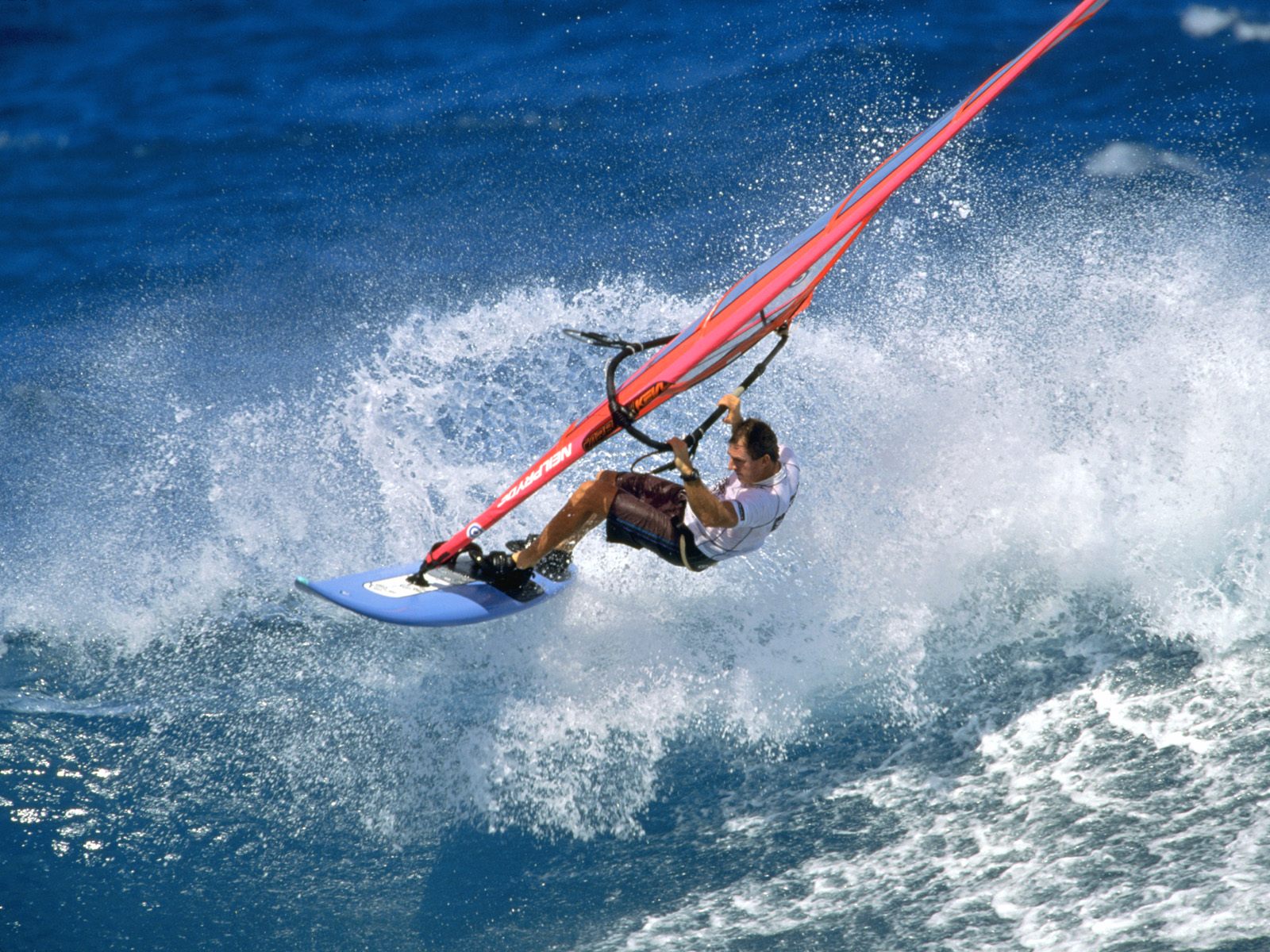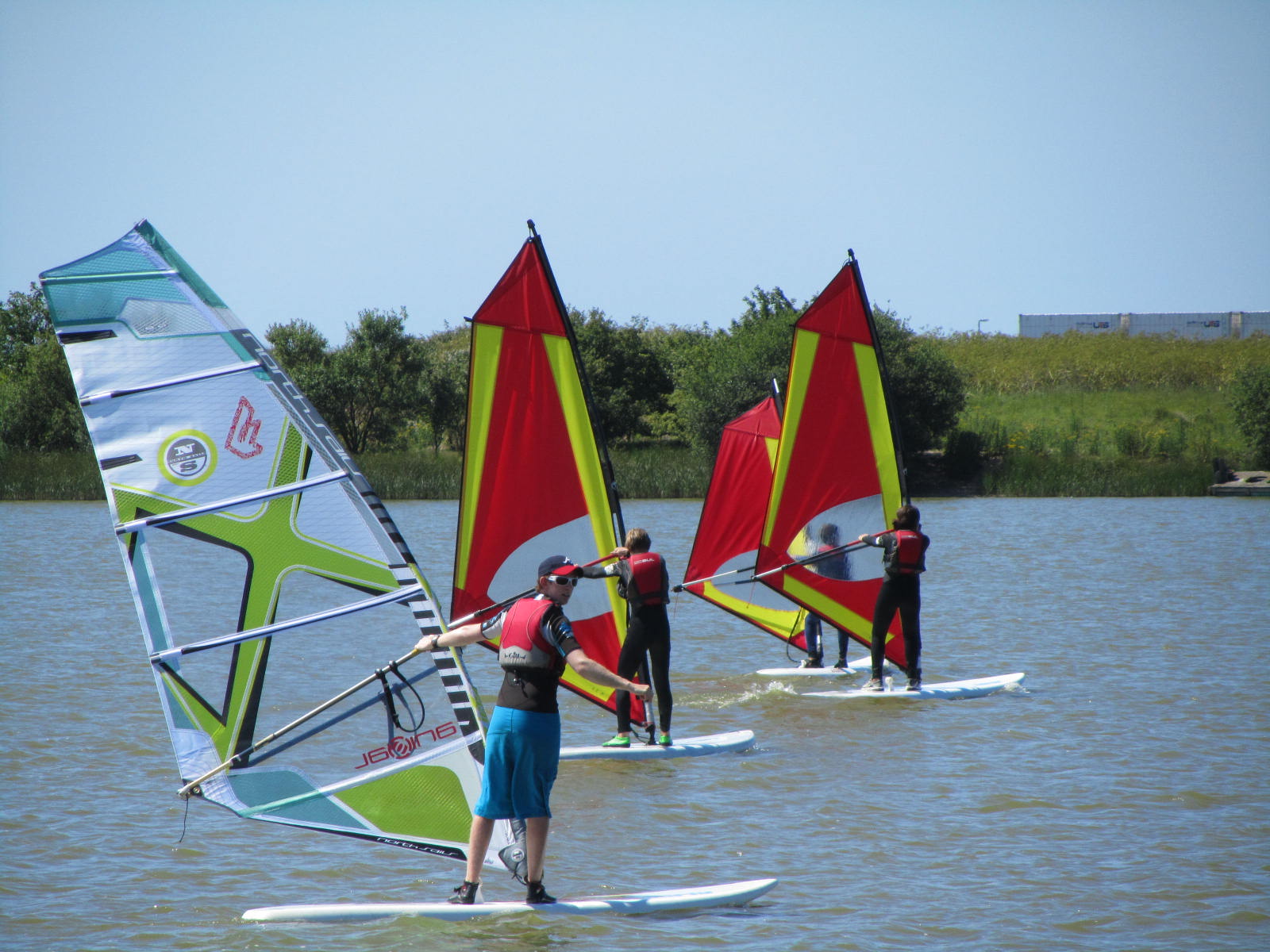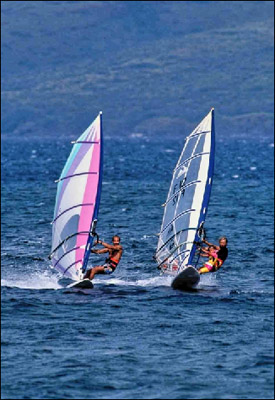Source(google.com.pk)
Wind Surfing Biography
"Windsurf" redirects here. For the cruise ship, see msy Wind Surf.
A windsurfer tilts the rig and carves the board to perform a planing (or carve) jibe (downwind turn) close to shore at Maui, Hawaii.
Robby Naish competing in a wave sailing event at Sylt, Germany.
A windsurfer in the final stages of a forward roll at Sardinia, Italy.
Olympic gold medalist Gal Fridman
Windsurfing is a surface water sport that combines elements of surfing and sailing. It consists of a board usually 2 to 3 metres long, with a volume of about 60 to 250 liters, powered by wind on a sail. The rig is connected to the board by a free-rotating universal joint and consists of a mast, 2-sided boom and sail. The sail area generally ranges from 2.5 m2 to 12 m2 depending on the conditions, the skill of the sailor and the type of windsurfing being undertaken.
Some credit S. Newman Darby with the origination of windsurfing by 1965[1] on the Susquehanna River, Pennsylvania, USA when he invented the "sailboard", which, incidentally, he did not patent.[2][3][4][5][6] In 1964, Darby began selling his sailboards.[4] A promotional article by Darby was published in the August 1965 edition of Popular Science magazine. While Darby's "sailboard" incorporated a pivoting rig, it was "square rigged" and suffered all the associated limitations. You operated the sailboard with your back to the lee side of the kite shaped square sail. Darby's article boasted that "...you can learn to master a type of manoeuvering that's been dead since the age of the picturesque square riggers"
Darby sailboard, Popular Science, 1965
Windsurfing can be said to straddle both the laid-back culture of surf sports and the more rules-based environment of sailing. Although it might be considered a minimalistic version of a sailboat, a windsurfer offers experiences that are outside the scope of any other sailing craft design. Windsurfers can perform jumps, inverted loops, spinning maneuvers, and other "freestyle" moves that cannot be matched by any sailboat. Windsurfers were the first to ride the world's largest waves, such as Jaws on the island of Maui, and, with very few exceptions, it was not until the advent of tow-in surfing that waves of that size became accessible to surfers on more traditional surfboards. Extreme waves aside, many expert windsurfers will ride the same waves as wavesurfers do (wind permitting) and are themselves usually very accomplished without a rig on a conventional surfboard.
At one time referred to as "surfing's ginger haired cousin" by the sport's legendary champion, Robby Naish,[7] windsurfing has long struggled to present a coherent image of the sport to outsiders. As a result of attempts to claim the word "windsurfer" as a trademark, participants have been encouraged to use different names to describe the sport, including "sailboarding" and "boardsailing". The term "windsurfing" has persisted as the accepted name for the sport, and the word "windsurfer" persists for both participants and equipment.
Windsurfing is predominately undertaken on a non-competitive basis. Organised competition does take place at all levels across the world and typical formats for competitive windsurfing include Formula Windsurfing, speed sailing, slalom, course racing, wave sailing, superX, and freestyle. These events are exciting to watch as sailors push the limits both physically and creatively with moves that look as impossible as thinking them up in the first place.
The boom of the 1980s led windsurfing to be recognized as an Olympic sport in 1984. However, windsurfing's popularity saw a sharp decline in the mid-1990s, thanks to licensing battles, and equipment becoming more specialized and requiring more expertise to sail. The sport experienced a modest revival, as new beginner-friendly designs became available.
However, starting in the 2000s, large numbers of avid windsurfers started giving up the sport and switching to the sport of Kitesurfing in a process known as "Going to the Dark Side" – an allusion to Star Wars and joining a rival sport.





















Wind Surfing Biography
"Windsurf" redirects here. For the cruise ship, see msy Wind Surf.
A windsurfer tilts the rig and carves the board to perform a planing (or carve) jibe (downwind turn) close to shore at Maui, Hawaii.
Robby Naish competing in a wave sailing event at Sylt, Germany.
A windsurfer in the final stages of a forward roll at Sardinia, Italy.
Olympic gold medalist Gal Fridman
Windsurfing is a surface water sport that combines elements of surfing and sailing. It consists of a board usually 2 to 3 metres long, with a volume of about 60 to 250 liters, powered by wind on a sail. The rig is connected to the board by a free-rotating universal joint and consists of a mast, 2-sided boom and sail. The sail area generally ranges from 2.5 m2 to 12 m2 depending on the conditions, the skill of the sailor and the type of windsurfing being undertaken.
Some credit S. Newman Darby with the origination of windsurfing by 1965[1] on the Susquehanna River, Pennsylvania, USA when he invented the "sailboard", which, incidentally, he did not patent.[2][3][4][5][6] In 1964, Darby began selling his sailboards.[4] A promotional article by Darby was published in the August 1965 edition of Popular Science magazine. While Darby's "sailboard" incorporated a pivoting rig, it was "square rigged" and suffered all the associated limitations. You operated the sailboard with your back to the lee side of the kite shaped square sail. Darby's article boasted that "...you can learn to master a type of manoeuvering that's been dead since the age of the picturesque square riggers"
Darby sailboard, Popular Science, 1965
Windsurfing can be said to straddle both the laid-back culture of surf sports and the more rules-based environment of sailing. Although it might be considered a minimalistic version of a sailboat, a windsurfer offers experiences that are outside the scope of any other sailing craft design. Windsurfers can perform jumps, inverted loops, spinning maneuvers, and other "freestyle" moves that cannot be matched by any sailboat. Windsurfers were the first to ride the world's largest waves, such as Jaws on the island of Maui, and, with very few exceptions, it was not until the advent of tow-in surfing that waves of that size became accessible to surfers on more traditional surfboards. Extreme waves aside, many expert windsurfers will ride the same waves as wavesurfers do (wind permitting) and are themselves usually very accomplished without a rig on a conventional surfboard.
At one time referred to as "surfing's ginger haired cousin" by the sport's legendary champion, Robby Naish,[7] windsurfing has long struggled to present a coherent image of the sport to outsiders. As a result of attempts to claim the word "windsurfer" as a trademark, participants have been encouraged to use different names to describe the sport, including "sailboarding" and "boardsailing". The term "windsurfing" has persisted as the accepted name for the sport, and the word "windsurfer" persists for both participants and equipment.
Windsurfing is predominately undertaken on a non-competitive basis. Organised competition does take place at all levels across the world and typical formats for competitive windsurfing include Formula Windsurfing, speed sailing, slalom, course racing, wave sailing, superX, and freestyle. These events are exciting to watch as sailors push the limits both physically and creatively with moves that look as impossible as thinking them up in the first place.
The boom of the 1980s led windsurfing to be recognized as an Olympic sport in 1984. However, windsurfing's popularity saw a sharp decline in the mid-1990s, thanks to licensing battles, and equipment becoming more specialized and requiring more expertise to sail. The sport experienced a modest revival, as new beginner-friendly designs became available.
However, starting in the 2000s, large numbers of avid windsurfers started giving up the sport and switching to the sport of Kitesurfing in a process known as "Going to the Dark Side" – an allusion to Star Wars and joining a rival sport.
Wind Surfing

Wind Surfing

Wind Surfing

Wind Surfing

Wind Surfing

Wind Surfing

Wind Surfing

Wind Surfing

Wind Surfing

Wind Surfing

Wind Surfing

Wind Surfing

Wind Surfing

Wind Surfing

Wind Surfing

Wind Surfing

Wind Surfing
Wind Surfing

Wind Surfing
Wind Surfing
Wind Surfing

Wind Surfing

Wind Surfing

No comments:
Post a Comment